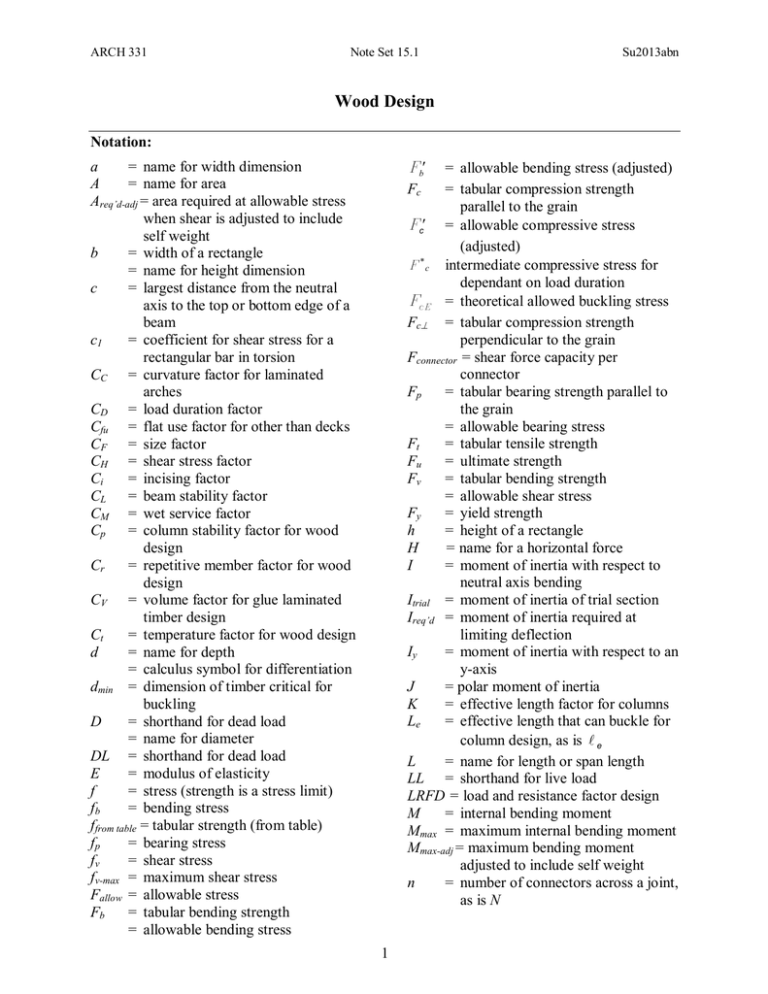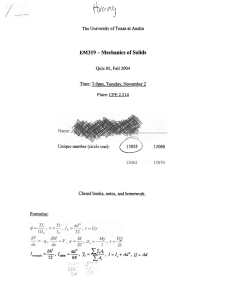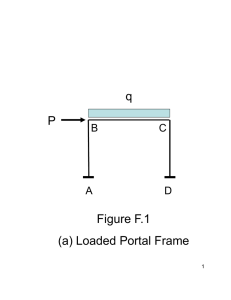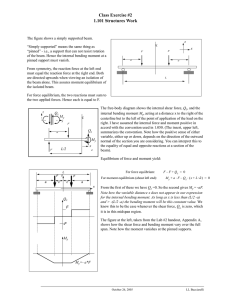Wood Design
advertisement

ARCH 331 Note Set 15.1 Su2013abn Wood Design Notation: Fb Fc a = name for width dimension A = name for area Areq’d-adj = area required at allowable stress when shear is adjusted to include self weight b = width of a rectangle = name for height dimension c = largest distance from the neutral axis to the top or bottom edge of a beam c1 = coefficient for shear stress for a rectangular bar in torsion CC = curvature factor for laminated arches CD = load duration factor Cfu = flat use factor for other than decks CF = size factor CH = shear stress factor Ci = incising factor CL = beam stability factor CM = wet service factor Cp = column stability factor for wood design Cr = repetitive member factor for wood design CV = volume factor for glue laminated timber design Ct = temperature factor for wood design d = name for depth = calculus symbol for differentiation dmin = dimension of timber critical for buckling D = shorthand for dead load = name for diameter DL = shorthand for dead load E = modulus of elasticity f = stress (strength is a stress limit) fb = bending stress ffrom table = tabular strength (from table) fp = bearing stress fv = shear stress fv-max = maximum shear stress Fallow = allowable stress Fb = tabular bending strength = allowable bending stress = allowable bending stress (adjusted) = tabular compression strength parallel to the grain Fc = allowable compressive stress (adjusted) * F c intermediate compressive stress for dependant on load duration FcE = theoretical allowed buckling stress Fc = tabular compression strength perpendicular to the grain Fconnector = shear force capacity per connector Fp = tabular bearing strength parallel to the grain = allowable bearing stress Ft = tabular tensile strength Fu = ultimate strength Fv = tabular bending strength = allowable shear stress Fy = yield strength h = height of a rectangle H = name for a horizontal force I = moment of inertia with respect to neutral axis bending Itrial = moment of inertia of trial section Ireq’d = moment of inertia required at limiting deflection Iy = moment of inertia with respect to an y-axis J = polar moment of inertia K = effective length factor for columns Le = effective length that can buckle for column design, as is e L = name for length or span length LL = shorthand for live load LRFD = load and resistance factor design M = internal bending moment Mmax = maximum internal bending moment Mmax-adj = maximum bending moment adjusted to include self weight n = number of connectors across a joint, as is N 1 ARCH 331 Note Set 15.1 p = pitch of connector spacing = safe connector load parallel to the grain P = name for axial force vector Pallowable = allowable axial force q = safe connector load perpendicular to the grain Qconnected = first moment area about a neutral axis for the connected part r = radius of gyration = interior radius of a laminated arch R = radius of curvature of a deformed beam = radius of curvature of a laminated arch = name for a reaction force S = section modulus Sreq’d = section modulus required at allowable stress Sreq’d-adj = section modulus required at allowable stress when moment is adjusted to include self weight Su2013abn T = torque (axial moment) V = internal shear force Vmax = maximum internal shear force Vmax-adj = maximum internal shear force adjusted to include self weight w = name for distributed load wself wt = name for distributed load from self weight of member W = shorthand for wind load x = horizontal distance y = vertical distance Z = force capacity of a connector actual = actual beam deflection allowable = allowable beam deflection limit = allowable beam deflection limit max = maximum beam deflection = density or unit weight = = = = slope of the beam deflection curve radial distance symbol for integration summation symbol Wood or Timber Design Structural design standards for wood are established by the National Design Specification (NDS) published by the National Forest Products Association. There is a combined specification (from 2005) for Allowable Stress Design and limit state design (LRFD). Tabulated wood strength values are used as the base allowable strength and modified by appropriate adjustment factors: F CDCM CF ... Ffrom table Size and Use Categories Boards: Dimension lumber Timbers 1 to 1½ in. thick 2 in. and wider 2 to 4 in. thick 2 in. and wider 5 in. and thicker 5 in. and wider 2 ARCH 331 Note Set 15.1 Su2013abn Adjustment Factors (partial list) CD CM CF load duration factor wet service factor (1.0 dry < 16% moisture content) size factor for visually graded sawn lumber and round timber > 12” depth CF (12 / d ) Cfu Ci Ct Cr CH CV CL CC 1 9 1.0 flat use factor (excluding decking) incising factor (from increasing the depth of pressure treatment) temperature factor (at high temperatures (also see Table 5.2 in text) strength decreases) repetitive member factor shear stress factor (amount of splitting) volume factor for glued laminated timber (similar to CF) beam stability factor (for beams without full lateral support) curvature factor for laminated arches Tabular Design Values Fb: Ft: Fv: Fc: Fc: E: Fp: bending stress tensile stress horizontal shear stress compression stress (perpendicular to grain) compression stress (parallel to grain) modulus of elasticity bearing stress (parallel to grain) Wood is significantly weakest in shear and strongest along the direction of the grain (tension and compression). Load Combinations and Deflection The critical load combination is determined by the largest of either: dead load ( dead load any combination of live load ) or 0.9 CD The deflection limits may be increased for less stiffness with total load: LL + 0.5(DL) 3 ARCH 331 Note Set 15.1 Su2013abn Criteria for Design of Beams Allowable normal stress or normal stress from LRFD should not be exceeded: Knowing M and Fb, the minimum section modulus fitting the limit is: Fb f b Mc I S req' d M Fb Besides strength, we also need to be concerned about serviceability. This involves things like limiting deflections & cracking, controlling noise and vibrations, preventing excessive settlements of foundations and durability. When we know about a beam section and its material, we can determine beam deformations. Determining Maximum Bending Moment Drawing V and M diagrams will show us the maximum values for design. Remember: V (w)dx M (V )dx dV w dx dM V dx Determining Maximum Bending Stress For a prismatic member (constant cross section), the maximum normal stress will occur at the maximum moment. For a non-prismatic member, the stress varies with the cross section AND the moment. Deflections If the bending moment changes, M(x) across a beam of constant material and cross section then the curvature will change: The slope of the n.a. of a beam, , will be tangent to the radius of curvature, R: slope 1 M ( x)dx EI 1 M ( x) R EI The equation for deflection, y, along a beam is: y 1 1 dx EI EI M ( x)dx Elastic curve equations can be found in handbooks, textbooks, design manuals, etc.. Computer programs can be used as well (like Multiframe). 4 ARCH 331 Note Set 15.1 Su2013abn Elastic curve equations can be superpositioned ONLY if the stresses are in the elastic range. The deflected shape is roughly the same shape flipped as the bending moment diagram but is constrained by supports and geometry. Boundary Conditions The boundary conditions are geometrical values that we know – slope or deflection – which may be restrained by supports or symmetry. At Pins, Rollers, Fixed Supports: At Fixed Supports: y=0 =0 At Inflection Points From Symmetry: =0 The Slope Is Zero At The Maximum Deflection ymax: dy slope 0 dx Allowable Deflection Limits All building codes and design codes limit deflection for beam types and damage that could happen based on service condition and severity. ymax ( x) actual allowable L Use LL only Roof beams: Industrial L/180 Commercial plaster ceiling L/240 no plaster L/360 Floor beams: Ordinary Usage L/360 Roof or floor (damageable elements) DL+LL L/120 L/180 L/240 L/240 L/480 5 value ARCH 331 Note Set 15.1 Su2013abn Lateral Buckling With compression stresses in the top of a beam, a sudden “popping” or buckling can happen even at low stresses. In order to prevent it, we need to brace it along the top, or laterally brace it, or provide a bigger Iy. Beam Loads & Load Tracing In order to determine the loads on a beam (or girder, joist, column, frame, foundation...) we can start at the top of a structure and determine the tributary area that a load acts over and the beam needs to support. Loads come from material weights, people, and the environment. This area is assumed to be from half the distance to the next beam over to halfway to the next beam. The reactions must be supported by the next lower structural element ad infinitum, to the ground. Design Procedure The intent is to find the most light weight member satisfying the section modulus size. 1. Know F’ for the material or FU for LRFD. 2. Draw V & M, finding Mmax. 3. Calculate Sreq’d. This step is equivalent to determining f b 4. For rectangular beams - S bh 2 6 M max Fb S For timber: use the section charts to find S that will work and remember that the beam self weight will increase Sreq’d. wself wt A ****Determine the “updated” Vmax and Mmax including the beam self weight, and verify that the updated Sreq’d has been met.****** 5. Consider lateral stability. 6. Evaluate horizontal shear stresses using V max to determine if f v Fv or find Areq’d For rectangular beams f vmax 7. Provide adequate bearing area at supports: 8. Evaluate shear due to torsion 3V V 1.5 2A A fp Areq' d 3V 2 Fv P Fc or Fc A T T or Fv J c1 ab 2 (circular section or rectangular) fv 9. Evaluate the deflection to determine if max LL LLallowed and/or max Total Totalallowed **** note: when calculated > limit, Irequired can be found with: and Sreq’d will be satisfied for similar self weight ***** 6 I req' d too big I trial lim it ARCH 331 Note Set 15.1 Su2013abn FOR ANY EVALUATION: Redesign (with a new section) at any point that a stress or serviceability criteria is NOT satisfied and re-evaluate each condition until it is satisfactory. Load Tables for Uniformly Loaded Joists & Rafters Tables exists for the common loading situation for joists and rafters – that of uniformly distributed load. The tables either provide the safe distributed load based on bending and deflection limits, they give the allowable span for specific live and dead loads. If the load is not uniform, an equivalent distributed load can be calculated from the maximum moment equation. Decking Flat panels or planks that span several joists or evenly spaced support behave as continuous beams. Design tables consider a “1 unit” wide strip across the supports and determine maximum bending moment and deflections in order to provide allowable loads depending on the depth of the material. The other structural use of decking is to construct what is called a diaphragm, which is a horizontal or vertical (if the panels are used in a shear wall) unit tying the sheathing to the joists or studs that resists forces parallel to the surface of the diaphragm. Criteria for Design of Columns If we know the loads, we can select a section that is adequate for strength & buckling. If we know the length, we can find the limiting load satisfying strength & buckling. Any slenderness ratio, Le/d 50: fc P Fc A Fc Fc C D C M Ct C F C p The allowable stress equation uses factors to replicate the combination crushing-buckling curve: where: Fc’ = allowable compressive stress parallel to the grain Fc = compressive strength parallel to the grain CD = load duration factor CM = wet service factor (1.0 for dry) Ct = temperature factor CF = size factor 2 1 FcE / Fc* 1 ( FcE / Fc* ) FcE / Fc* Cp = column stability factor off chart Cp or equation: 2c 2c c 7 ARCH 331 Note Set 15.1 Su2013abn For preliminary column design: Fc Fc*C p Fc C D C p Procedure for Analysis 1. Calculate Le/dmin (KL/d for each axis and chose largest) 2. Obtain F’c compute FcE K cE E le 2 with KcE =0.3 for sawn, = 0.418 for glu-lam d 3. Compute Fc* Fc C D with CD = 1, normal, CD =1.25 for 7 day roof, etc.... 4. Calculate FcE Fc* and get Cp from table or calculation 5. Calculate Fc Fc*C p 6. Compute Pallowable = FcA or alternatively compute factual = P/A 7. Is the design satisfactory? Is P Pallowable? yes, it is; no, it is no good or Is factual F’c? yes, it is; no, it is no good Procedure for Design 1. Guess a size by picking a section 2. Calculate Le/dmin (KL/d for each axis and choose largest) 3. Obtain F’c compute FcE K cE E le 2 with KcE =0.3 for sawn, = 0.418 for glu-lam d 4. Compute Fc* Fc C D with CD = 1, normal, CD =1.25 for 7 day roof... 5. Calculate FcE Fc* and get Cp from table or calculation 6. Calculate Fc Fc*C p 7. Compute Pallowable = FcA or alternatively compute factual = P/A 8. Is the design satisfactory? Is P Pallowable? yes, it is; no, pick a bigger section and go back to step 2. or Is factual F’c? yes, it is; no, pick a bigger section and go back to step 2. Trusses Timber trusses are commonly manufactured with continuous top or bottom chords, but the members are still design as compression and tension members (without the effect of bending.) 8 ARCH 331 Note Set 15.1 Su2013abn Stud Walls Stud wall construction is often used in light frame construction together with joist and rafters. Studs are typically 2-in. nominal thickness and must be braced in the weak axis. Most wall coverings provide this function. Stud spacing is determined by the width of the panel material, and is usually 16 in. The lumber grade can be relatively low. The walls must be designed for a combination of wind load and bending, which means beam-column analysis. Columns with Bending (Beam-Columns) 2 The modification factors are included in the form: where: 1 fc f bx 1.0 f c Fc Fbx 1 FcEx fc = magnification factor accounting for P- FcEx Fbx = allowable bending stress f bx = working stress from bending about x-x axis In order to design an adequate section for allowable stress, we have to start somewhere: 1. Make assumptions about the limiting stress from: - buckling - axial stress - combined stress 2. See if we can find values for r or A or S (=I/cmax) 3. Pick a trial section based on if we think r or A is going to govern the section size. 4. Analyze the stresses and compare to allowable using the allowable stress method or interaction formula for eccentric columns. 5. Did the section pass the stress test? - If not, do you increase r or A or S? - If so, is the difference really big so that you could decrease r or A or S to make it more efficient (economical)? 6. Change the section choice and go back to step 4. Repeat until the section meets the stress criteria. Laminated Arches The radius of curvature, R, is limited because of residual bending stresses between lams of thickness t to 100t for Southern pine and hardwoods and 250t for softwoods. The allowable bending stress for combined stresses is Fb F b( C F CC ) 9 ARCH 331 Note Set 15.1 where CC 1 2000 t r Su2013abn 2 and r is the radius to the inside of the lamination. Criteria for Design of Connections Connections for wood are typically mechanical fasteners. Shear plates and split ring connectors are common in trusses. Bolts of metal bear on holes in wood, and nails rely on shear resistance transverse and parallel to the nail shaft. Timber rivets with steel side plates are allowed with glue laminated timber. Connections must be able to transfer any axial force, shear, or moment from member to member or from beam to column. Bolted Joints Stress must be evaluated in the member being connected using the load being transferred and the reduced cross section area called net area. Bolt capacities are usually provided in tables and take into account the allowable shearing stress across the diameter for single and double shear, and the allowable bearing stress of the connected material based on the direction of the load with respect to the grain. Problems, such as ripping of the bolt hole at the end of the member, are avoided by following code guidelines on minimum edge distances and spacing. Nailed Joints Because nails rely on shear resistance, a common problem when nailing is splitting of the wood at the end of the member, which is a shear failure. Tables list the shear force capacity per unit length of embedment per nail. Jointed members used for beams will have shear stress across the connector, and the pitch spacing, p, can be determined from VQconnected area nFconnector p the shear stress equation when the capacity, F, is known: I Example 1 (pg 328) Fc = 440 psi , = 36.3 lb/ft3 10 ARCH 331 Note Set 15.1 Example 1 (continued) 11 Su2013abn ARCH 331 Note Set 15.1 Example 2 (pg 379) 12 Su2013abn ARCH 331 Note Set 15.1 Example 3 (pg 381) Fc = 1650 psi , E = 1.8 x 106 psi Also verify with allowable load tables 13 Su2013abn ARCH 331 Note Set 15.1 Su2013abn Example 4 F’b = 2152 psi Fc = 1350 psi A = 8.25 in2 Sx* = 7.56 in 3 378 LB (D only) CD = 1.6 from wind loading 0.35 = 2376(0.35) = 832 psi 16in 12 in / ft 809 832 14 0.399 ARCH 331 Note Set 15.1 Example 5 Example 6 A nominal 4 x 6 in. redwood beam is to be supported by two 2 x 6 in. members acting as a spaced column. The minimum spacing and edge distances for the ½ inch bolts are shown. How many ½ in. bolts will be required to safely carry a load of 1500 lb? Use the chart provided. 15 Su2013abn ARCH 331 Note Set 15.1 Example 7 16 Su2013abn ARCH 331 Note Set 15.1 Example 7 (continued) 17 Su2013abn ARCH 331 Note Set 15.1 Su2013abn ASD Beam Design Flow Chart Collect data: L, , , limits; find beam charts for load cases and actual equations Collect data: Fb & Fv and all adjustment factors (CD, etc.) Find Vmax & Mmax from constructing diagrams or using beam chart formulas Find Sreq’d and pick a section from a table with Sx greater or equal to Sreq’d Calculate self wt. using A found and . Find Mmax-adj & Vmax-adj. No Calculate Sreq’d-adj using Mmax-adj. Is Sx(picked) Sreq’d-adj? (OR calculate fb. Is fb F’b?) Yes Calculate Areq’d-adj using Vmax-adj. Is A(picked) Areq’d-adj? (OR calculate fv. Is fv F’v?) No pick a new section with a larger area Calculate max using superpositioning and beam chart equations with the Ix for the section is max limits? This may be both the limit for live load deflection and total load deflection.) Yes 18 (DONE) I req' d too big I trial lim it No pick a section with a larger I x




